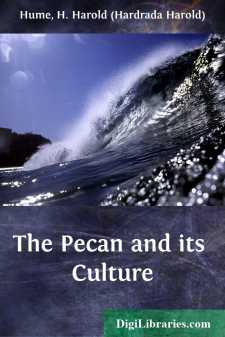Categories
- Antiques & Collectibles 13
- Architecture 36
- Art 48
- Bibles 22
- Biography & Autobiography 813
- Body, Mind & Spirit 142
- Business & Economics 28
- Children's Books 17
- Children's Fiction 14
- Computers 4
- Cooking 94
- Crafts & Hobbies 4
- Drama 346
- Education 46
- Family & Relationships 57
- Fiction 11829
- Games 19
- Gardening 17
- Health & Fitness 34
- History 1377
- House & Home 1
- Humor 147
- Juvenile Fiction 1873
- Juvenile Nonfiction 202
- Language Arts & Disciplines 88
- Law 16
- Literary Collections 686
- Literary Criticism 179
- Mathematics 13
- Medical 41
- Music 40
- Nature 179
- Non-Classifiable 1768
- Performing Arts 7
- Periodicals 1453
- Philosophy 64
- Photography 2
- Poetry 896
- Political Science 203
- Psychology 42
- Reference 154
- Religion 513
- Science 126
- Self-Help 84
- Social Science 81
- Sports & Recreation 34
- Study Aids 3
- Technology & Engineering 59
- Transportation 23
- Travel 463
- True Crime 29
The Pecan and its Culture
Categories:
Description:
Excerpt
CHAPTER I.
COMMERCIAL AND ORNAMENTAL IMPORTANCE OF THE PECAN.
In all-around excellence, the pecan is equalled by none of the native American nut-bearing trees and certainly it is surpassed by no exotic species. It stands in the list of nut trees with but few equals and no superiors. With this fact known and admitted by all, it seems reasonable to suppose that the pecan will be grown and cultivated much more extensively than it now is. Its intrinsic worth deserves a large share of attention, more than it has received. At present it is gaining a position of so much importance as an orchard tree, that, ere long, it will become an extremely important item in the horticultural wealth of the Southern and Southwestern States.
Large quantities of pecans are sold in the American markets. These are the product of uncultivated or forest trees. Many orchards of considerable size, planted with meritorious budded and grafted varieties, are now in bearing, but the product of these plantings is entirely used by what may be termed a private trade, either by seedsmen, or by private individuals for dessert purposes. Some day, varieties of pecans will become known in the markets just as varieties of grapes, apples or pears are known. People ask for Niagara or Concord grapes, Northern Spy or Greening apples, Bartlet or Seckel pears—ask for what they want, and know what they are getting. The day is far distant when Frotscher, Schley, San Saba, Curtis, Georgia or other varieties of pecans will be known by name by the purchasing public, asked for in the markets and recognized when procured. But that time must and will come, and until then there is no danger of the industry being overdone, and not even then, because our population is constantly growing; because the pecan nut is being put to a variety of new uses, and as yet the export trade is comparatively undeveloped. (See table, page 15.) It would seem then that the pecan might reasonably be expected to replace to a certain extent the foreign nuts in our own markets.
According to the investigations of Woods and Merrill,[A] the pecan has a higher food value than either the walnut, filbert, cocoanut, almond or peanut. The results of their analyses are as follows:
EDIBLE PORTION.Edible Portion.Water.Protein.Fat.Carbohydrates.Ash.Fuel Value per Pound.per cent.pr ct.pr ct.pr ct.pr ct.pr ct.CaloriesPecans, kernels100.02.910.370.814.31.73445Walnuts, kernels100.02.816.761.414.81.33305Filberts, kernels100.03.715.665.313.02.43290Cocoanuts, shred'd...3.56.357.331.61.33125Almonds, kernels100.04.821.054.917.32.03030Shelled Peanuts100.01.630.549.216.22.52955Plate II. An Avenue Shaded by Pecan Trees.It is a fact worthy of note that the average man requires 3,500 calories of energy each day, an amount which must be secured from food consumed. One pound of pecan kernels, according to the above analysis, would supply 3,445 calories, or only 55 calories less than the amount required per day. We are not, be it understood, pointing out this fact because we believe that the pecan alone would be a satisfactory food, though it is wholesome, nourishing and palatable and should be used in larger quantities than is usually the case, but simply to emphasize its high food value.
According to the foregoing analysis, the pecan is richer in fat than any of the other nuts. Seventy per cent. of the kernels is fat. The pecan may at some time be in requisition as a source of oil—an oil which would doubtless be useful for salad purposes—but it is never likely to be converted into oil until the present prices of the nuts are greatly reduced.
If we turn from the dietary value of the nut to the ornamental value of the tree, we cannot but be forcibly impressed with its value as a shade and ornamental tree. For these purposes it may be planted far outside the area in which fruit may be reasonably expected. If given good soil and sufficient food supply, it grows quite rapidly, making a stately, vigorous, long-lived tree. In its native forests it is a giant tree, sometimes reaching a height of upwards of two hundred feet with a trunk of six feet. Isolated specimens, grown in the open, come to maturity with wide-spreading branches and the whole tree has an exceedingly graceful appearance. Wherever it will succeed, no other shade tree is so worthy of attention as the pecan, and in the fruiting area, beauty and healthful shade may be combined with utility....


